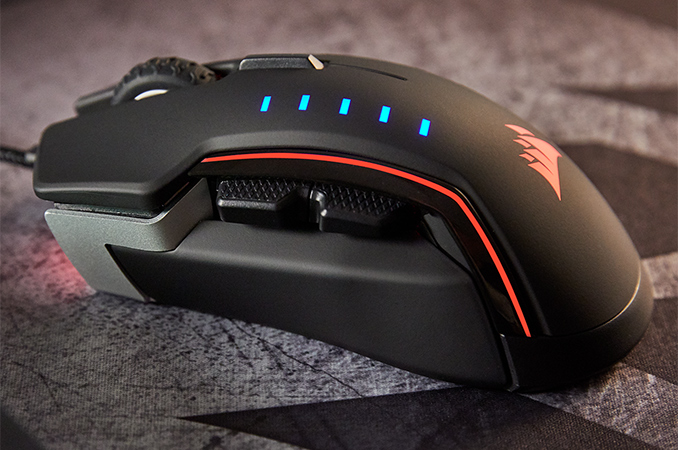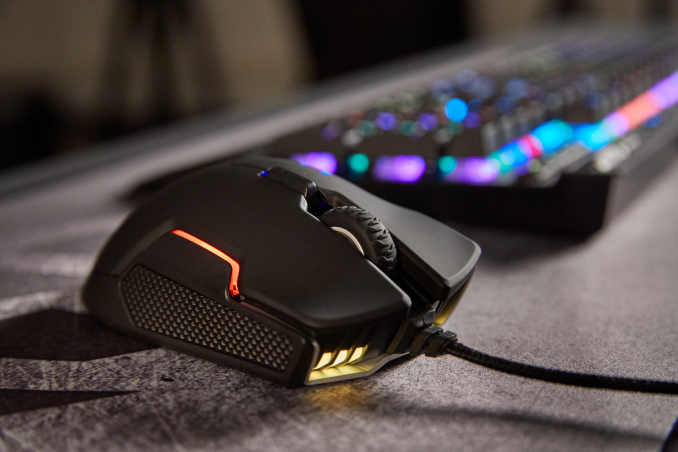Corsair Launches Glaive RGB Mouse: 16,000 DPI, Interchangeable Grips, LEDs
by Anton Shilov on May 6, 2017 10:00 AM EST- Posted in
- Peripherals
- Gaming
- Corsair
- Mice
- RGB
- Glaive RGB

Corsair this week released its latest flagship gaming mouse, the new Glaive RGB. The company's latest right-handed mouse incorporates a new sensor, interchangeable grips, programmable RGB lighting as well as on-board storage for profiles. And, as you'd expect for such a mouse, Corsair is aiming solidly at the high-end market, going after gamers looking for a high-end wired mouse.
With the rise of PC gaming in the recent years, multiple companies have entered the market of gaming peripherals with mice, keyboards, headsets and other gear. As a result, the choice of gaming hardware in general and mice in particular became a complicated task as various devices feature different ergonomics and performance. With its new flagship Glaive RGB mouse, Corsair decided to somewhat simplify the choice: the Glaive RGB uses a rather advanced and sensitive IR sensor, and pairs that up with three interchangeable magnetic grips. The smooth, the rubberized and the wide thumb rest grips were designed to allow the mouse to be used with different types of hands and usage models, enabling the Glaive RGB to compete against various rivals with diverse shapes. To customize the look of the mouse further, Corsair equipped it with three RGB LEDs that can be programmed using the company’s proprietary software.
The Corsair Glaive RGB is based on a custom version of Pixart’s PMW3367 gaming sensor with adjustable sensitivity and up to a 16,000 DPI resolution (acceleration supported at that DPI is unknown). The microcontroller of the sensor supports USB report rate of up to 1000 Hz (programmable and requires support from the OS) and the mouse comes with a braided fiber cable. Just like any other high-end mouse for gamers, the Glaive RGB has programmable buttons that can be completely remapped using Corsair’s CUE software, and then used on different computers as button configuration is stored inside the mouse. Besides, the onboard storage is used to store DPI, macros and RGB LED settings.
As for the build, the Glaive RGB mouse features metallic skeleton and is made of rubberized plastic. Depending on the version of the mouse, parts of the metallic skeleton that go outside the body are either painted or not.
Corsair’s Glaive RGB mouse is now available directly from the company as well as its resellers worldwide. In the U.S., the Glave RGB costs $69.99, whereas in Europe gamers will have to pay €79.99.
Related Reading:
- Corsair Vengeance RGB DDR4 Memory Modules with LEDs Now on Sale
- CORSAIR ONE Gaming PC Released
- The Corsair Gaming K95 RGB Platinum Mechanical Keyboard Review
- Corsair’s Bulldog 2.0 Gets Kaby Lake-Compatible Z270 Motherboard, New Cooler
- Razer Announces The Lancehead Gaming Mice
- Logitech Launches G203 Prodigy Gaming Mouse with A New 6000 DPI Sensor
- Razer Updates The DeathAdder Elite Gaming Mouse
- Logitech Announces The Ambidextrous G900 Chaos Spectrum Gaming Mouse
Source: Corsair




















17 Comments
View All Comments
Inteli - Saturday, May 6, 2017 - link
Wow 2/10 not enough RGBs. It only has 3 RGBs, I expect at least 10 RGBs on my gaming peripherals. Honestly, though, this thing is a brick. 122 grams without the cable is ridiculous, and I think the industry should start getting away from ridiculously heavy mice, and more mice should weigh ~90 grams and include some weights very close to the sensor like the G403 does.By the way, you linked the datasheet for the 3310 sensor. The 3367 is a variant of the 3360 that honestly doesn't do enough different to warrant its own sensor besides for more DPIz.
boeush - Saturday, May 6, 2017 - link
With ultra-high DPI the weight isn't so important, since you don't have to move the mouse much in order to move the cursor a lot. Whereas w light mouse would more easily respond to random hand tremors or desk surface vibrations, and would make it more difficult to take effective advantage of all that DPI...Death666Angel - Saturday, May 6, 2017 - link
I know quite a few low sensitivity gamers who have to use their whole (normal sized) mousepad to turn 30° or so in CS. They appreciate a light weight mouse I'm sure.Inteli - Saturday, May 6, 2017 - link
Well, but why would anybody actually need to use 12,000 or 16,000 DPI? Maybe if you had severe arthritis or RSI and a 7680x4320 desktop resolution. For most people, even on high resolution displays, 3200 DPI is plenty.Even at high DPIs, especially for first person games but not exclusively, a lighter weight is objectively superior unless you have serious movement stability issues. A lighter weight mouse requires less force to initiate movement and less force to stop movement, which is less fatiguing overall. A lighter weight mouse with a weight adjustment system would also accommodate a larger group of people, such as those with high sensitivities (<10"/360) and lower sensitivities (>20"/360).
There is no reason for anybody to make mice that feel like bricks with PTFE pads on the bottom except for the false preconceived notion that more weight indicates a better build quality.
Sushisamurai - Sunday, May 7, 2017 - link
Let's not kid ourselves - I'm confident most hardcore gamers have a strong right forearm from activities other than gaming, or from the result of being a hardcore gamerhelvete - Thursday, July 20, 2017 - link
lolZeDestructor - Monday, May 8, 2017 - link
Some of us just like heavier miceInteli - Monday, May 8, 2017 - link
So add the weights from the weight adjustment system I advocated for. It allows for a mouse that is much more usable by everyone, and means personal preference only comes down to shape (and sensor if you still prefer the MLT04 for some reason).ZeDestructor - Monday, May 8, 2017 - link
I was mostly replying to your opinion on how objectively better lighter mice are.I'm personally a big fan of adjustable weighting on my mice and love it on my G500 and G502
radioguy728 - Wednesday, May 10, 2017 - link
Amen I still have my G500